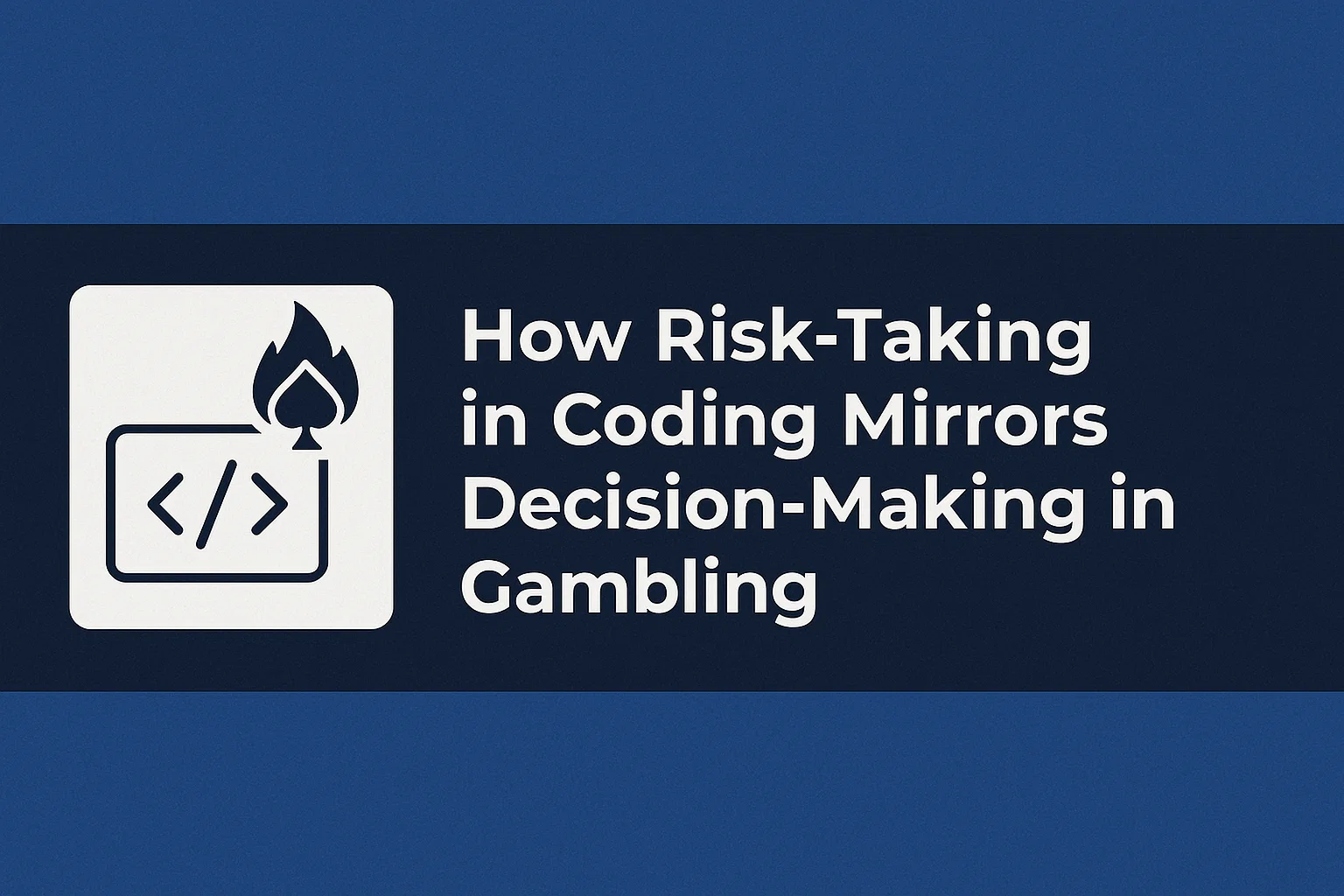navigation
categories
recent posts
- Audio editing on Intel Macs
- Working big: ACM interviews Werner Vogels of Amazon
- Blogs & Social Media Forum - Opening Session
- video blogging: an aggregration
- Checking Out AJAX generated code
- Dance through the ages
- Note to world: time to pay up
- We Media Fringe - Suw Speaks
- Blog Blast
- David Weiss: A Tour of Microsoft's Mac Lab
feed me
- Subscribe with Atom
- Subscribe with RSS
- Find out more about feeds
How Risk-Taking in Coding Mirrors Decision-Making in Gambling

Good coders and smart gamblers both make many small choices under uncertainty. They both weigh odds, manage risk, learn fast from feedback, and protect their bankroll (or their codebase) from big, sudden losses. This article shows you the clear links, in simple words, with steps you can use today.
What You Will Learn
- What “risk” means in coding and in gambling
- How to think in odds and expected value (EV) with very simple math
- How tests, reviews, rollbacks, and feature flags act like “insurance”
- How to avoid common human biases that push bad bets and bad commits
- A step-by-step checklist to choose better options when you code
- Where to read more from trusted sources on software risk and responsible gambling
Why Compare Coding and Gambling?
At first, it may feel odd to compare these worlds. Coders build tools and products. Gamblers place bets in games of chance and skill. But the same brain sits behind both. We face unclear info, we feel time pressure, and we decide anyway. The core skill is the same: make a good decision now, protect the future, and learn with each step.
Plain Definitions
Risk (in simple words)
Risk is the chance that something bad will happen, and how big the damage is if it does. More chance or more damage means more risk.
Risk in Coding
Risk in coding is the chance your change breaks something now or later. Think bugs in production, data loss, slow pages, angry users, or missed deadlines.
Risk in Gambling
Risk in gambling is the chance you lose your stake. The risk is higher when the odds are low or the stake is big compared to your bankroll.
Side-by-Side: Coding vs Gambling
| Theme | Coding | Gambling | Shared Lesson |
|---|---|---|---|
| Bankroll | Error budget / time budget / compute budget | Money set aside to play | Protect your budget first; survive to play again |
| Bet Size | Scope of change in one PR | Amount staked per hand/spin | Keep bets small; avoid “all-in” commits |
| Odds | Chance a change works in prod | Chance to win a hand/spin | Estimate odds; improve them with tests and research |
| Insurance | Unit tests, CI, code review, feature flags, backups | Table limits, stop-loss rules | Use safety nets to limit damage |
| Learning | Post-mortems, A/B tests, telemetry | Hand history, session notes | Review, learn, adjust strategy |
| Exit | Rollback / revert / canary off | Fold the hand / walk away | Have a clear, fast exit plan |
Expected Value (EV) — The One Idea You Need
EV says: think in averages over time. If a move wins often and loses small, it has a good EV. If it wins rare but loses big, it has a bad EV.
Tiny math: EV = (chance of success × gain) − (chance of failure × loss).
- In coding: A small PR with high success chance and quick rollback has better EV than a huge PR that takes days to fix if wrong.
- In gambling: A small stake on a fair game is safer than a big stake on a high-house-edge game.
Train your team to ask this before each change: “What is the EV of this deploy?” This alone stops many bad decisions.
Bankroll = Error Budget
Good teams set an error budget (how much failure is allowed before we must slow down). This is like a gambler’s bankroll rule. When the budget is low, you play tighter: smaller changes, more tests, more reviews, or a feature freeze. When the budget is healthy, you can ship a bit faster.
For a clear model on error budgets and reliability, see Google’s SRE ideas on Service Level Objectives and overload & risk.
Bet Sizing = Pull Request Sizing
In casinos, smart players bet small and steady. In code, smart teams open small, focused PRs. Small PRs:
- Are easy to review
- Are easy to test
- Are easy to revert
- Carry less risk and less stress
Use your VCS well: learn Git basics, keep branches short-lived, and prefer many small merges over one giant merge.
Insurance Tools That Cut Risk Fast
- Unit & integration tests catch bugs early. See Martin Fowler on testing.
- Code review finds edge cases and risky logic. Keep reviews kind and focused. Google’s review guide is a great start.
- CI/CD gives fast feedback and safer deploys. A simple pipeline beats a manual “hope and push.”
- Feature flags let you turn off a bad change fast. You can ship “dark” and gradually turn features on.
- Backups & rollbacks limit worst-case loss. Practice restores. A backup you never tested is not a backup.
- Security basics (input checks, auth, dependency scans) cut huge downside risk. Start with OWASP Top 10.
A/B Tests = Controlled Bets
In gambling, you learn from many small, repeatable events. In product work, you can run an A/B test: two versions, one small change, clear metric, short time. You do not guess. You measure. See simple A/B testing guidance and keep it ethical and transparent.
Variance and Why Tests Matter
Variance is how much outcomes swing around the average. Games with high variance can give big wins and big losses. Big, untested change sets are high-variance too. They can look great on your laptop and fail in prod. Tests reduce variance. So do canaries, small rollouts, and staged traffic.
Three Risk Ladders You Can Use
1) Change Size Ladder
- Low risk: Text fix, copy tweak, small CSS rule
- Medium: One endpoint refactor with tests
- High: New database, auth change, payment flow
2) Environment Ladder
- Low: Local + unit tests
- Medium: Staging + synthetic tests
- High: Production behind flag / canary
3) Rollout Ladder
- Low: 1% traffic for 30 minutes
- Medium: 10% for one hour
- High: 100% only after alerts stay green
Biases That Hurt Both Coders and Gamblers
- Overconfidence: “It will work because I wrote it.” Add tests and review to humble your guess.
- Gambler’s fallacy: “We failed twice, so now we must succeed.” Odds do not “balance out.”
- Sunk cost: “We already spent weeks; we can’t stop.” You can. Consider the EV from now.
- Hot hand illusion: A few wins do not change true odds. Keep discipline.
- Recency bias: The last incident feels bigger than it is. Use data, not fear.
For helpful, plain guides on human bias and decisions, see The Decision Lab and the short articles from Behavioral Economics resources.
Simple Decision Framework (Works for Both)
- Define the goal: What outcome do we want? (Speed, quality, safety, learning?)
- List options: At least three. If you have only one, you are stuck; if two, you are in a trap.
- Estimate odds and impact: Use a quick EV table (see below).
- Plan the stop: When do we fold or roll back? What metric tells us to stop?
- Place a small bet: Ship the smallest safe step (flagged, staged, or canary).
- Measure: Watch key metrics (latency, errors, conversion, support tickets).
- Review: Do a light post-mortem. Update runbooks.
EV Table You Can Copy
| Option | Success Chance | Gain if Success | Failure Chance | Loss if Failure | EV (Quick) |
|---|---|---|---|---|---|
| Small PR + flag | 80% | +2% conversion | 20% | Quick rollback | Positive |
| Huge PR | 60% | +3% conversion | 40% | Hours of outage | Likely negative |
Ethics and Responsibility
We must talk about harm. Gambling can be fun, but it can also hurt people when control is lost. When we code, our choices can also hurt users if we ignore safety, privacy, or access needs. The shared rule is simple: protect people first, then seek upside.
- See the NCSC cloud security collection for safe design basics.
- Read NIST Privacy Framework to handle user data with care.
- For responsible play support, see BeGambleAware and Responsible Gambling Council.
Small, Real-World Stories
1) The risky refactor
A team wants to upgrade a core library. Big jump, many breaking changes. They split work into five tiny PRs, add tests first, and ship behind a flag. Each PR is a small bet. Two PRs roll back in minutes. The final outcome is a safe upgrade. EV was high because the losses were capped.
2) The new feature with a trap
Product wants a bold UI change. The team sets a 1% canary, adds clear stop rules, and defines success as a +1% click-through with no rise in errors. After one hour, errors climb. They fold (turn the flag off). They lost little time and no trust. Then they fix and try again.
3) The data migration
They need to move 30M rows. They slice the work, take backups, rehearse on a copy, and set alerts. They run at low traffic hours. When a batch slows, they pause, review logs, and continue. The “bet size” per step stays tiny. Risk stays small.
Practical Guardrails You Can Add This Week
- Define error budgets for key services.
- Adopt small PRs: aim for under 300 lines per change.
- Add a fast test layer: unit tests must finish in minutes.
- Automate CI/CD with a basic pipeline and clear checks.
- Use feature flags for risky changes.
- Canary deploys for user-facing code.
- Post-mortems after incidents—blame-free, focused on lessons.
- Runbooks for rollbacks, restores, and on-call steps.
Words and Models You May Hear (Plain English)
- House edge: Long-term advantage for the casino. In code, the “house edge” is the constant risk of bugs and failure. You beat it with discipline.
- Kelly criterion: A formula to size bets. In code, “Kelly-like” means: never stake more than a small percent of your budget on one deploy.
- Risk matrix: A grid of low/med/high chance vs low/med/high impact. Use it to rank tasks quickly.
- SLO/SLI/SLA: Targets and measures for service health. Tie risk to these numbers.
How to Talk About Gambling in a Healthy Way
This article makes a learning link between coding and gambling. It is not a push to gamble. If you or someone you know needs help, visit BeGambleAware or NCPG.
Trusted Reading to Go Deeper
- Google SRE Book (free online)
- OWASP Top 10 (security risk basics)
- The Twelve-Factor App (safer services)
- MDN Web Docs (clear web platform guidance)
- Git Documentation (clean commits and rollbacks)
- NIST Risk Management (bigger-picture risk ideas)
Where a Natural Link to a Gambling Review Site Fits
When you explain odds, return-to-player (RTP), and game rules to a general audience, it is helpful to send readers to a simple, well-organized review source where they can read the basics about games, RTP, and risk. For example, if you discuss classic slots and how RTP changes risk over time, it is natural to reference a clear, educational guide like Book-of-Ra-slot.com so readers can see how variance, paylines, and features work in practice. Keep the context educational and responsible, not sales-like.
trackbacks
TrackBack URL for this entry: https://imajes.info/mt/mt-diespammersdie.cgi/329




